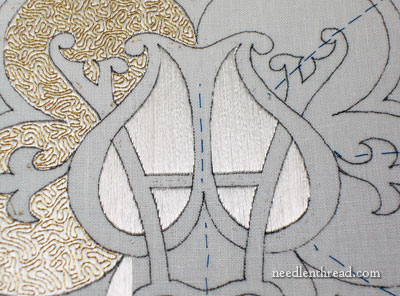Lately, I’ve been stitching upside-down.
(How’s the visual on that? Not so good?)
I am not upside-down – but my design is.
Working with the design upside-down for the area I’ve been filling with silk, I’ve found that I’ve been stitching much faster because the reach to the area I’m working is not quite as far.
Depending on the embroidery project, you’re perfectly justified in turning your design upside-down. There are some embroidery techniques where doing so wouldn’t work so well, but with this type of flat stitchery, to avoid reaching far to the top of the design, it’s much easier just to turn the frame 180 degrees.

My progress so far: the center of the monogram is filled with silk. Now it’s just a matter of couching the gold over the silk to hold all those little strands in place.

The more I stitch with Au Ver a Soie’s Soie Ovale, the more I love, love, love, love, love this thread. It is really unlike any other flat silk on the market. The closest thing that comes to it is the Japanese silk used for Japanese embroidery, but I think Soie Ovale has a bit more body to it. It is a super nice thread!
Flat silk is fiddly to work with, but once you get the hang of it, it’s not as bad as it seems. Two things will help a stitcher use flat silk with ease: 1. the manner in which the needle is held and the stitch taken; and 2. The equipment used when stitching.
When you first encounter flat silk and take a stab at stitching with it, you might find that the silk snags on the edges of your fingers where you hold the needle, and just about everywhere else that it possibly could snag. The key here is control – controlling the silk by the way the needle is held and the way the stitch is taken. After the first few stitches, you’ll discover that keeping the needle perpendicular to the fabric when the stitch is taken makes all the difference in the world when stitching with this type of thread. Straight up and down with the needle, and many “problems” of working with flat silk are instantly solved. The thread must also be kept under control, and this is best done by the tools you need when working with flat silk.
The first tool – the flat-silk-embroiderer’s Best Friend – is the laying tool. The laying tool keeps tension on the silk as the stitch is taken, which keeps all the tiny filaments of silk together during the progress of the stitch, and this keeps the silk from bunching up or knotting as the thread is pulled through the fabric. The laying tool also keeps the filaments of silk lying flat and parallel, so that the whole thread lies smooth and covers well.
Using a laying tool pre-supposes another tool: a stand for the embroidery frame. This type of thread requires that both hands are free for stitching – one to work the needle and thread and the other to manage the laying tool. So a needlework stand (or at least some method of securing your frame so that both hands are free) is essential.

Progress from afar.
I’m really enjoying this part of the Medallion project. I love the materials I’m working with and I really love this technique. In a sense, it is very meditative work. There are no complicated stitches or techniques to confuse or muddle things up here; it’s just a matter of working steadily. So, some good music in the background (yes, Christmas music – I’m a Christmas Music Fanatic, I’m afraid) and … ahhhh! … Perfect Bliss!
If you’d like to follow this project from its beginnings, you’re welcome to visit the Medallion Project index, where you’ll find every article listed chronologically so that you can follow along step by step.
Have a wonderful weekend!





